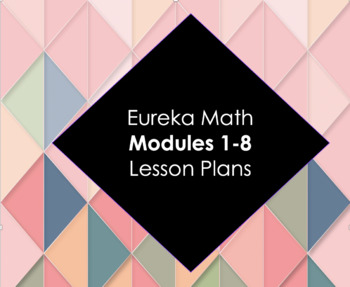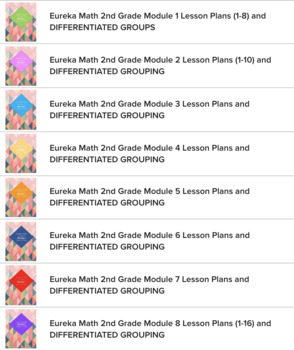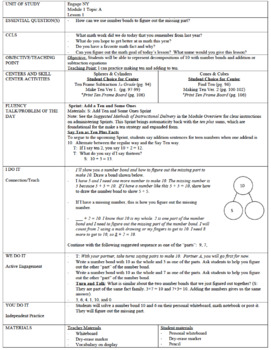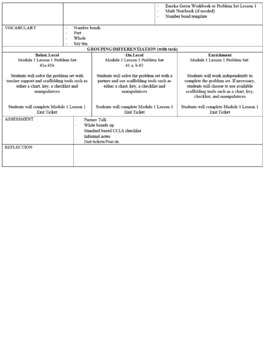Eureka Math 2nd Grade Modules 1-8 with DIFFERENTIATED GROUPING
- Zip
Products in this Bundle (8)
showing 1-5 of 8 products
Description
This is a Eureka Math lesson plan that follows the "I do, We do, You do" method of teaching. This product contains most lesson plans in Modules 1-8 (see below). This plan includes opportunities for student discussion and activities using "Hands up" for teacher assessment.
There are assessment and problem set opportunities for THREE DIFFERENTIATED GROUPS (below level, on level and enrichment).
There are Center choices listed from K5 centers. You can find it for purchase on the following link.
https://www.k-5mathteachingresources.com/math-centers.html
Spheres and Cylinders- Low/Mid-Low Level Group
Cones and Cubes - Mid-High/High Level Group
Also, there are differentiated problems associated with the Problem Set from the Eureka Math workbook. If your school does not purchase the workbooks, the problem sets and exit tickets are available for free download from https://www.engageny.org/
Please note, based on recommendations from Great Minds Eureka Math and Eureka Math's Notes on Pacing, the following lessons have been modified, consolidated or omitted:
Click links to purchase module lesson plans separately
Module 1: All lesson plans
- Lessons 4 and 5 are consolidated into one plan with material from both lessons on the plan (Eureka Math's Notes on Pacing)
- Lesson 10 has additional CUVAS worksheets to use for word solving. See "Low Group" sheet for explanation of CUVAS. Also, this is an optional resource. You can use the RDW approach to solve word problems. My school likes to use this method.
- Lesson 15 has additional CUVAS worksheets to use for word solving. See "Low Group" sheet for explanation of CUVAS. Also, this is an optional resource. You can use the RDW approach to solve word problems.
- Lesson 18 has been omitted as it is an OPTIONAL lesson (Eureka Math's Notes on Pacing)
- Lessons 5 and 16 are word problem solving lessons in which I use the CUVAS strategy. There are worksheets attached for each lesson with this strategy. However, this strategy is not necessary to use. You can use the read, draw, write (RDW) strategy as outlined in Eureka.
- Lesson 10 is omitted because it is very similar to lesson 9. Lesson 9 includes material from Lesson 10 about showing expanded form. (Eureka Math's Notes on Pacing)
- Lesson 13 is omitted and place value disk drawing is incorporated into lessons 11 and 12. (Eureka Math's Notes on Pacing)
- Lesson 18 and 19 are omitted and vertical form is taught with place value disk drawings in lesson 20 and 21. (Eureka Math's Notes on Pacing)
- Lesson 26 is omitted and place value disk drawing is incorporated into lessons 24 and 25. (Eureka Math's Notes on Pacing)
- Lesson 29 and 30 is consolidated into one lesson due to pacing purposes. (Eureka Math's Notes on Pacing)
- Lesson 7- Share and critique solution strategy is used in all lessons. They are used in turn and talk opportunities
- Lesson 8-9- Relate manipulative representations to the addition algorithm. Manipulatives are used in all lessons as an aid. Lesson 10 and 11 incorporates manipulatives, drawings, and the addition algorithm (Eureka Math's Notes on Pacing)
- Lesson 13- Relate manipulative representations to subtraction algorithm- this is once again incorporated already in Lessons 14 and 15 when we are using math drawings and relating it to a written algorithm (Eureka Math's Notes on Pacing)
- Lesson 1 & 2 are consolidated into one lesson (Eureka Math's Notes on Pacing)
- Lesson 3&4 are consolidated into one lesson (Eureka Math's Notes on Pacing)
- Lesson 11- Omitted and taught in Lesson 10.
- Lesson 13 - Omitted because the concept is a 3rd grade standard (Eureka Math's Notes on Pacing)
- Lesson 16- Omitted because not directly related to 2nd grade standards (Eureka Math's Notes on Pacing)
- Lesson 14 - Omitted because very similar to Lesson 15 (Eureka Math's Notes on Pacing)
- Lesson 26- Omitted because very similar to Lesson 25 (Eureka Math's Notes on Pacing)
Module 8: All lessons





